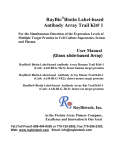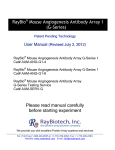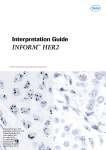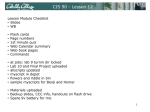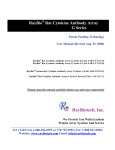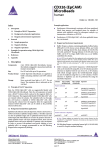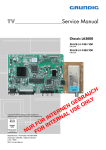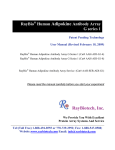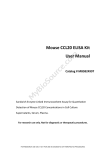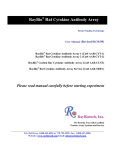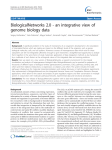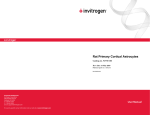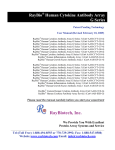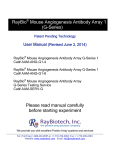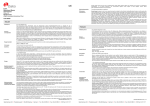Download RayBio
Transcript
RayBio® Rat Cytokine Antibody Array G Series Patent Pending Technology User Manual (Revised February 18, 2008) RayBio® Rat Cytokine Antibody Array G Series 1 (Cat# AAR-CYT-G1-4) RayBio® Rat Cytokine Antibody Array G Series 2 (Cat# AAR-CYT-G2-4) RayBio® Rat Cytokine Antibody Array G Series 1 (Cat# AAR-CYT-G1-8) RayBio® Rat Cytokine Antibody Array G Series 2 (Cat# AAR-CYT-G2-8) RayBio® Custom Rat Cytokine Antibody Array G Series 1 (Cat# AAR-CUST-G) RayBio® Rat Cytokine Antibody Array G Series 1 Service (Cat# AAR-SER-G) Please read the manual carefully before you start your experiment RayBiotech, Inc. We Provide You With Excellent Protein Array Systems And Service Tel:(Toll Free) 1-888-494-8555 or 770-729-2992; Fax: 1-888-547-0580; Website:www.raybiotech.com Email: [email protected] RayBiotech, Inc. RayBio® Rat Cytokine Antibody Array G Series Protocol TABLE OF CONTENTS I. Introduction……..……………………………... 2 How It Works………………………..………… 5 Materials Provided…………………………….. 6 Additional Materials Required………………… 6 III. Overview and General Considerations………… 7 A. Preparation of Samples……………………… 7 B. Handling Glass Chips ………………………. 8 C. Incubation…………………………………… 8 IV. Protocol………………………………………… 9 A. Blocking and Incubation……………………. 9 B. Detection……………………………………. 12 Interpretation of Results……………………….. 13 VI. Troubleshooting Guide………………………… 18 VII. Selected References Using RayBiotech Products 19 II. V. Cytokine Antibody Arrays are RayBiotech patent-pending technology. RayBio® is the trademark of RayBiotech, Inc. RayBio® Rat Cytokine Antibody Array G series 1 I. Introduction All cell functions, including cell proliferation, cell death and differentiation, as well as maintenance of health status and development of disease, are controlled by many genes and signaling pathways. New techniques such as cDNA microarrays have enabled us to analyze the global gene expression 1-3. However, almost all cell functions are executed by proteins, which cannot be studied by DNA and RNA alone. Experimental analysis clearly shows a disparity between the relative expression levels of mRNA and their corresponding proteins 4. Therefore, it is critical to analyze the protein profile. Currently, two-dimensional polyacrylamide SDS page coupled with mass spectrometry is the mainstream approach to analyzing multiple protein expression levels 5,6. However, the requirement of sophisticated devices and the lack of quantitative measurements greatly limit its broad application. Thus, no simple, cost effective, and rapid method of analysis of multiple protein expression levels has been available to researchers until now. Our RayBio® Rat Cytokine Antibody Array is the first commercially available rat cytokine antibody array system 7-11. By using the RayBiotech system, scientists can rapidly and accurately identify the expression profiles of multiple cytokines in several hours inexpensively. The RayBiotech kit (G series) is a glass chip format. The kit provides a highly sensitive approach to simultaneously detect multiple cytokine expression levels from cell culture supernatant, patient’s serum, tissue lysate and other sources. The arrays are manufactured using non-contact arrayer. The experimental procedure is simple and can be performed in any laboratory. The signals from G series arrays are detected using a laser scanner. Besides the products listed in this manual, RayBiotech also provides RayBio® Mouse Cytokine Antibody Array G series 2000 for simultaneous detection of 144 mouse cytokines in single experiment. RayBiotech also provides RayBio® Human Cytokine Antibody Array G series 4000 which is the only product available in the market that can detect 274 human cytokines in single experiment. We also provide quantitative antibody arrays which can RayBio® Rat Cytokine Antibody Array G series 2 quantitatively measure multiple protein expression in antibody array technology. Pathway-specific array systems allow investigators to focus on the specific problem and are becoming an increasingly powerful tool in cDNA microarray system. RayBiotech’s first protein array system, known as RayBio® Rat Cytokine Antibody Array, is particularly useful compared with the Rat cytokine cDNA microarray system. Besides the ability to detect protein expression, RayBiotech’s system is a more accurate reflection of active cytokine levels because it only detects secreted cytokines, and no amplification step is needed. Furthermore, it is much simpler, faster, environmentally friendlier, and more sensitive. Simultaneous detection of multiple cytokines undoubtedly provides a powerful tool to study cytokines. Cytokines play an important role in innate immunity, apoptosis, angiogenesis, cell growth and differentiation 12. Cytokines are involved in most disease processes, including cancer and cardiac diseases. The interaction between cytokines and the cellular immune system is a dynamic process. The interactions of positive and negative stimuli, and positive as well as negative regulatory loops are complex and often involve multiple cytokines. Reference List 1. LPS induces the interaction of a transcription factor, LPS-induced TNF-a factor, and STAT6(B) with effects on multiple cytokines. Tang X, Marciano DL, Leeman SE, Amar S. PNAS. 2005 ;102(14): 5132-5137. 2. HIV-1-mediated apoptosis of neuronal cells: Proximal molecular mechanisms of HIV-1-induced encephalopathy. Xu Y, Kulkoshy J, Pomerantz RJ. PNAS. 2004 ;101(18): 7071-7075. 3. Synergistic increases in intracellular Ca(2+), and the release of MCP-1, RANTES, and IL-6 by astrocytes treated with opiates and HIV-1 Tat. El-Hage N, Gurwell JA, Singh IN, Knapp PE, Nath A, Hauser KF. GLIA. 2005;50(2):91106. RayBio® Rat Cytokine Antibody Array G series 3 4. Bone Marrow Stroma Influences Transforming Growth Factor-β Production in Breast Cancer Cells to Regulate c-myc Activation of the Preprotachykinin-I Gene in Breast Cancer Cells. Oh HS, Moharita A, Potian JG, Whitehead IP, et al. Cancer Res. 2004; 64:6327-6336. 5. Recombinant Herpes Simplex Virus Type 1 (HSV-1) Codelivering Interleukin12p35 as a Molecular Adjuvant Enhances the Protective Immune Response against Ocular HSV-1 Challenge. Osario Y, Ghiasi H. J Virology 2005; 79(6):3297-3308. 6. Dysregulated Inflammatory Response to Candida albicans in a C5-Deficient Mouse Strain. Mullick A, Elias M, Picard S, Gros P. Infect Immunity. 2004; .72(10):5868-5849. 7. Leukotriene B4 Strongly Increases Monocyte Chemoattractant Protein-1 in Human Monocytes. Huang L, Zhao A, Wong F, Ayala JM, Cui J. Arterioscler Thromb Vascul Biol. 2004;24:1783-1788 8. Giroux M, Denis F. Human CD1d-unrestricted NKT cells release chemokines upon Fas engagement. Blood. 2005;105(2):703–710. 9. Monitoring the response of orthotopic bladder tumors to granulocyte macrophage colony-stimulating factor therapy using the prostate-specific antigen gene as a reporter. Wu Q, Esuvaranathan K, Mahendran R. Clin Cancer Res. 2004; 10(20):6977-84. 10. Neuroglial activation and neuroinflammation in the brain of patients with autism (p NA). Vargas DL, Nascimbene C, Krishnan C, Zimmerman AW, Pardo CA. Ann Neurol. 2005; 57(1): 67 – 81. 11. Cytokine profiling of macrophages exposed to Porphyromonas gingivalis, its LPS or its FimA. Zhou Q, Desta T, Graves DT, Amar S. Infect Immunity. 2005; 73(2):935-43. 12. Veto-like activity of mesenchymal stem cells: functional discrimination between cellular responses to alloantigens and recall antigens. Rameshwar P. Journal of Immunology. 2003;171(7):3426-34. 13. The promise of cytokine antibody arrays in drug discovery process. Huang RP, Yang W, Yang Y, Flowers L, et al. Expert Opinion on Drug Discovery. (2005) 9:601-615. RayBio® Rat Cytokine Antibody Array G series 4 Here’s how it works Array support Sample Incubation of Sample With arrayed antibody Supports Cocktail of Biotin-Ab Incubation with Biotinylated Ab 1-2 hrs 1-2 hrs Labeled – streptavidin Incubation with Labeled- streptavidin 2 hrs Detection of signals Data analysis and graph RayBio® Rat Cytokine Antibody Array G series 5 II. Materials Provided Upon receipt, all components of the RayBio® Rat Cytokine Antibody Array kit should be stored at -20°C. At -20°C the kit will retain complete activity for up to 6 months. Once thawed, the glass chips, Fluorescent dyestreptavidin, Internal Control and 2X Blocking Buffer should be kept at – 20°C and all other component should be stored at 4°C. Use within three months after reagents have been thawed. Please use within six months of purchase. • RayBio® Rat Cytokine Antibody Microarray slides (1 slide with 4 or 8 subarrays each) • Biotin-Conjugated Anti-Cytokines (1 tube/4 subarrays, 1 or 2 tubes) • 1,500X Fluorescent Dye-conjugated Streptavidin (Cy3 equivalent, 1 tube) • 2X Blocking Buffer (10 ml) • 20X Wash Buffer I (30 ml) • 20X Wash Buffer II (30 ml) • 2X Cell Lysis Buffer (10 ml) • RayBio® G series antibody array accessory (including slide incubation chamber, Gasket, Protective cover, Snap-on sides and adhesive film) • 30 ml tube • Manual Additional Materials Required • • • • • Orbital shaker Laser scanner for fluorescence detection Aluminum foil Distilled water Plastic box RayBio® Rat Cytokine Antibody Array G series 6 Layout of Rat G series Antibody Array Antibody Array Blank Blank Barcode Barcode 8 arrays in one glass chip 4 arrays in one glass chip III. Overview and General Considerations A. Preparation of Samples • Use serum-free conditioned media if possible. • If serum-containing conditioned media is required, use uncultured media as a negative control sample, since many types of sera contain cytokines. • For cell lysates and tissue lysates, we recommend using RayBio® Cell Lysis Buffer to extract proteins from cell or tissue (e.g. using homogenizer). Dilute 2X RayBio® Cell Lysis Buffer with H2O (we recommend adding proteinase inhibitors to Cell Lysis Buffer before use). After extraction, spin the sample down and save the supernatant for your experiment. Determine protein concentration. • We recommend using: o 50–100 µl of Conditioned media (undiluted), or o 50–100 µl of 2-fold to 5-fold diluted sera or plasma, or o 10–200 µg of total protein for cell lysates and tissue lysates. If you experience high background, you may further dilute your sample. RayBio® Rat Cytokine Antibody Array G series 7 B. Handling glass chips • The microarray slides are sensitive, do not touch the surface. Hold the slides by the edges only. • Handle all buffers and slides with powder-free gloves. • Avoid breaking glass slide. • Handle glass chip in clean environment. C. Incubation • Completely cover array area with sample or buffer during incubation, and cover the incubation chamber with adhesive film or plastic sheet protector to avoid drying. • Avoid foaming during incubation steps. • Perform all incubation and wash steps under gentle rotation. • Cover the incubation chamber with adhesive film during incubation, particularly when incubation is more than 2 hours or 50 µl of sample or reagent is used. • Avoid cross-contamination from overflowing solution to neighboring wells. • Several incubation steps such as step 3 (blocking), step 4 (sample incubation), step 9 (biotin-Ab incubation) or step 12 (Fluorescent dyestreptavidin incubation) may be done at 4°C for overnight. Please make sure to cover the incubation chamber tightly to prevent evaporation. RayBio® Rat Cytokine Antibody Array G series 8 IV. Protocol A. Blocking and Incubation 1. Take the glass chip out from the box. Let air dry for 2 hours. 2. Assemble the glass chip into incubation chamber and incubation frame as shown below. (Note: if you slide has be assembled, you can go to step 3 directly). RayBio® Rat Cytokine Antibody Array G series 9 3. Add 100 µl 1 X Blocking Buffer into each well and incubate at room temperature for 30 min to block slides. Dilute 2X Blocking Buffer with H2O. Make sure no bubbles are in the well. Note: only add reagents to wells printed with antibodies. 4. Decant Blocking Buffer from each well. Add 50 to 100 µl of each sample to array III and array IV. Incubate arrays with sample at room temperature for 1 to 2 hours. Dilute sample using 1X Blocking Buffer if necessary. Note: Incubation may be done overnight at 4°C. Note: We recommend using 50 to 100 µl of undiluted conditioned media or 50 to 100 µl of 2-5 fold diluted serum or plasma or 10-200 µg of protein for cell lysates and tissue lysates. Dilute the lysate at least 10 fold with 1X blocking buffer to make a total volume of 50 to 100 µl. Make sure there are no bubbles in the wells. Note: The amount of sample used depends on the abundance of cytokines. More concentrated sample can be used if signals are too weak. If signals are too strong, the sample can be diluted further. 5. Decant the samples from each well, and wash 3 times with 150 µl of 1X Wash Buffer I at room temperature with gentle shaking. 2 min per wash. Dilute 20X Wash Buffer I with H2O. Completely remove wash buffer I in each wash step. Note: avoid solution flowing into neighboring wells. 6. Put the glass chip with frame into a box with 1X Wash Buffer I (cover the whole glass slide and frame with Wash Buffer I), and wash 2 times at room temperature with gentle shaking for 10 min per wash. 7. Decant the 1X Wash Buffer I from each well, Put the glass chip with frame into the box with 1X Wash Buffer II (cover the whole glass slide and frame with Wash Buffer II), and wash 2 times at room temperature with gentle shaking for 5 min per wash. Remove all of Wash Buffer II in the well. Dilute 20X Wash Buffer II with H2O. RayBio® Rat Cytokine Antibody Array G series 10 8. Prepare working solution for biotin-conjugated antibodies. After brief spin to force antibody aliquot to bottom of tube, add 300 µl of 1x blocking buffer to the Biotin-Conjugated Antibody tube. Mix gently. Note: the diluted biotin-conjugated antibodies can be stored at 4°C for 2-3 days. 9. Add 70 µl of diluted biotin-conjugated antibodies to each subarray. Incubate at room temperature for 2 hours. Note: incubation may be done at 4°C for overnight. 10. Wash as directed in steps 5 and then wash 3 times with 150 µl of 1X Wash Buffer II at room temperature with shaking. 2 min per wash. Completely remove wash buffer II in each wash step. 11. Add 70 µl of 1,500 fold diluted Fluorescent dye-conjugated streptavidin (after brief spin to force liquid to bottom of tube, add 1.5 ml of Blocking Buffer to Fluorescent dye-conjugated streptavidin tube) to each subarray. Cover the incubation chamber with Adhesive film. Cover the plate with aluminum foil to avoid exposure to light or incubate in dark room. 12. Incubate at room temperature for 1 to 2 hours. Note: incubation may be done at 4°C for overnight. 13. Wash with Wash Buffer I twice as directed in steps 5. B. Fluorescence Detection 1. Decant excess Wash Buffer from wells. RayBio® Rat Cytokine Antibody Array G series 11 2. Disassemble the slide out of the incubation frame and chamber. 3. Place the whole slide in a 30 ml centrifuge tube provided, add enough Wash Buffer I (about 20 ml) to cover the whole slide and gently shake at room temperature for 10 minutes. Decant Wash Buffer I. Repeat Wash Buffer I once. Wash with Wash Buffer II (about 20 ml) with gentle shake at room temperature for 10 minutes. Or wash using slide chamber. Rinse the slide with distilled H2O. 4. Remove water droplets by centrifuge at 1,000 rpm for 3 minutes and then let slide dry completely in air at least 20 minutes (protect from light). Make sure the slides are absolutely dry before the scanning procedure. 5. Image the signals using laser scanner such as Axon GenePix using cy3 or “green” channel (Excitation frequency 532 nm). Note: we recommend scanning slides right after experiment. You also can store the slide at –20°C in dark for several days. If you do not have a laser scanner, RayBiotech can provide service for you. Just simply send your slide to us and we will take care of it. RayBio® Rat Cytokine Antibody Array G series 12 V. Interpretation of Results: The following figure shows RayBio® Mouse Cytokine Antibody Array G series 1000 probed with different cell culture supernatant. The images were captured using laser scanner. The biotin-conjugated protein produces positive signals, which can be used to identify the orientation and to compare the relative expression levels among the different wells. The signal intensities obtained from laser scanner can simply be imported into our analysis tool. The analysis tool will help you: • • • • • • • Locate your signal intensities to antibody array map Link the protein to website for more detailed information on the particular protein Protein list sorting Average signal intensities Subtract background Normalize the data from different samples Obtain protein level comparison charts among different samples This analysis tool is very simple and affordable, which will not only assist in compiling and organizing your data, but also reduces your calculations to a “copy and paste” step. Conditioned medium Negative Control If you do not use our RayBio® Analysis Tool, you can locate the cytokines by referring to RayBio® Rat cytokine Antibody Array G series 1. RayBio® Rat Cytokine Antibody Array G series 13 Normalization and comparison For biomarker discovery or for analysis of large number of arrays, great attention must be paid to the normalization. Our antibody array design includes several controls for normalization and comparison of arrays performing in different membranes and different experiments (for more information please read the reference 13 in the introduction). Positive control. Positive control is biotinylated protein. It can be used to normalize the streptavidin incubation step. If the positive signals from different array membranes are similar, positive control is a simple and effective way for normalization. Negative control. Negative control is BSA. Normally, it should only give a background reading. Data Extraction Tips: • Ignore any comet tails • Define the area for signal capture for all spots as 110-120 micron diameter, using the same area for every spot. • Use median signal value, not the total or the mean • Use local background correction (also median value). • Exclude obvious outlier data in its calculations. Using these guidelines, along with using PMT, brightness and contrast settings that reduce the background as much as possible, we get very good results with interassay and intraassay CV <20%, even with some imperfections in the antibody spots. Threshold of significant difference in expression: Any ≥1.5-fold increase or ≤0.65-fold decrease in signal intensity for a single analyte between samples, provided that both signals are well above background (Mean background + 2 standard deviations, accuracy ≈ 95%). RayBio® Rat Cytokine Antibody Array G series 14 RayBio® Rat Antibody Array G - Series 1 Detect 19 cytokines in one experiment. a b c d e f g h 1 Pos 1 Pos 2 Pos 3 Neg Neg CINC-2 CINC-3 CNTF Fractalkine 2 Pos 1 Pos 2 Pos 3 Neg Neg CINC-2 CINC-3 CNTF Fractalkine 3 GM-CSF IFN-γ IL-1α IL-1β IL-4 IL-6 IL-10 LIX Leptin 4 GM-CSF IFN-γ IL-1α IL-1β IL-4 IL-6 IL-10 LIX Leptin 5 MCP-1 MIP-3α β-NGF TIMP-1 TNF-α VEGF Neg Neg Pos 1 6 MCP-1 MIP-3α β-NGF TIMP-1 TNF-α VEGF Neg Neg Pos 1 RayBio® Rat Cytokine Antibody Array G series 2 (for simultaneous detection of 34 rat cytokines) A B C D E F G H I J K L 1 POS 1 POS 2 POS 3 NEG Activin A Agrin B7-2/CD86 beta-NGF CINC-1 CINC-2alpha CINC-3 CNTF 2 POS 1 POS 2 POS 3 NEG Activin A Agrin B7-2/CD86 beta-NGF CINC-1 CINC-2alpha CINC-3 CNTF 3 Fas Ligand Fractalkine GM-CSF ICAM-1 IFN-gamma IL-1alpha IL-1beta IL-1 R6 IL-2 IL-4 IL-6 IL-10 4 Fas Ligand Fractalkine GM-CSF ICAM-1 IFN-gamma IL-1alpha IL-1beta IL-1 R6 IL-2 IL-4 IL-6 IL-10 Thymus Chemokine-1 Thymus Chemokine-1 5 IL-13 Leptin LIX L-Selectin MCP-1 MIP-3alpha MMP-8 PDGF-AA Prolactin R RAGE 6 IL-13 Leptin LIX L-Selectin MCP-1 MIP-3alpha MMP-8 PDGF-AA Prolactin R RAGE 7 TNF-alpha VEGF NEG NEG NEG NEG NEG NEG NEG NEG NEG POS 1 8 TNF-alpha VEGF NEG NEG NEG NEG NEG NEG NEG NEG NEG POS 1 TIMP-1 TIMP-1 Abbreviations: IP-10, Interferon-inducible protein-10; LAP, latency associated peptide (TGF-β1); LIF, leukocyte inhibitory factor. MMP, Matrix Metalloproteinase; Pos, positive control; Neg, negative control. All other are used standard abbreviations. RayBio® Rat Cytokine Antibody Array G series 15 RayBiotech, Inc., the protein array pioneer company, strives to research and develop new products to meet demands of the biomedical community. RayBio’s patent-pending technology allows detection of over 180 cytokines, chemokines and other proteins in a single experiment. Our format is simple, sensitive, reliable and cost effective. Products include: Cytokine Arrays, Chemokine Arrays, ELISA kits, Phosphotyrosine kits, Recombinant Proteins, Antibodies, and custom services. 1. Antibody arrays Cytokine antibody array Human cytokine antibody arrays Mouse cytokine antibody arrays Rat cytokine antibody arrays Pathway- or disease-focused antibody arrays Inflammation antibody array Angiogensis antibody array Chemokine antibody array Growth factor antibody array MMP antibody array Atherosclerosis antibody array Quantibody arrays for quantitative measurement of cytokine and other protein concentraton Phosphorylation antibody arrays Biotin label-based antibody arrays for high density antibody arrays. Antibody analysis tool, software 2. 3. 4. 5. 6. 7. 8. 9. ELISA Cell-based phosphorylation assay Custom antibody arrays Antibody Recombinant protein Peptide Protein arrays EIA RayBiotech also provides excellent custom service: 1. Antibody arrays RayBio® Rat Cytokine Antibody Array G series 16 2. 3. 4. 5. 6. 7. 8. Protein arrays Peptide synthesis Production of recombinant protein and antibody Peptide arrays Phosphorylation arrays ELISA EIA Just simply send your samples and we will do the assay for you. Technology transfer program Have you developed technologies or reagents interested to the scientific and research community? RayBiotech can help you commercialize your technologies, reagents and dream. RayBio® Rat Cytokine Antibody Array G series 17 VI. Troubleshooting guide Problem Weak signal High background Cause Recommendation Inadequate detection Check laser power and PMT parameters Inadequate reagent volumes or improper dilution Check pipetters and ensure correct preparation Short incubation times Ensure sufficient incubation Time and change sample incubation step to overnight Too low protein concentration in sample Don’t make too low dilution Or concentrate sample Improper storage of kit Store kit at suggested temperature Make sure correct amount of antibodies Excess of biotinylated antibodies Excess of streptavidin Make sure correct amount of streptavidin Inadequate detection Check laser power And PMT parameters dust Work in clean environment Increase wash time and use more wash buffer Insufficient wash Uneven signal Bubbles formed during incubation Avoid bubble formation during incubation Arrays are not completed Covered by reagent Completely cover arrays with solution RayBio® Rat Cytokine Antibody Array G series 18 VII. Selected References Using RayBiotech Products Human AB Serum and Thrombin-Activated Platelet-Rich Plasma Are Suitable Alternatives to Fetal Calf Serum for the Expansion of Mesenchymal Stem Cells from Adipose Tissue. Kocaoemer A, Kern S, Kluter H, Bieback K. Stem Cells. 2007; 25:1270-1278 ATP Binding by Monarch-1/NLRP12 Is Critical for Its Inhibitory Function. Ye Z, Lich JD, Moore CB, Duncan JA, Williams KL, Ting JP-Y. Mol Cell Biol. 2008;28:1841-1850. Infiltration of CD4+ lymphocytes into the brain contributes to neurodegeneration in a mouse model of Parkinson disease. Brochard V, Combadière B, Prigent A, Laouar Y, et al. J Clin Invest. 2009; 119 :182192. Transferrin-derived synthetic peptide induces highly conserved proinflammatory responses of macrophages. Haddad G, Belosevic M. Mol Immunol. 2009; 46:576-586. Robinson K, Vona-Davis L, Riggs D, Jackson B, McFadden D. Peptide YY Attenuates STAT1 and STAT3 Activation Induced by TNF-alpha in Acinar Cell Line AR42J. J Am Coll Surg. 2006; 2002:788-796. Stokes L, Surprenant A. Purinergic P2Y2 Receptors Induce Increased MCP-1/CCL2 Synthesis and Release from Rat Alveolar Peritoneal Macrophages. J Immunol. 2007;179:6016-6023. Struzynska L, Dabrowska-Bouta B, Koza K, Sulkowski G. InflammationLike Glial Response in Lead-Exposed Immature Rat Brain. Toxicol Sci. 2007;95(1):156-162. Watanabe M, Guo W, Zou S, Sugiyo S, Dubner R, Ren K. Neurosci Lett. 2005;382:128-133. RayBio® Rat Cytokine Antibody Array G series 19 Newman MB, Willing AE, Manresa JJ, Davis-Sanberg C, Sanberg PR. Stroke-induced Migration of Human Umbilical Cord Blood Cells: Time Course and Cytokines. Stem Cells Devel. 2005; 14:576-586. Moon SK, Woo J-I, Lee H-Y, Park R, et al. Toll-Like Receptor 2Dependent NF-kappa-B Activation Is Involved in Nontypeable Haemophilus influenzae-Induced Monocyte Chemotactic Protein 1 UpRegulation in the Spiral Ligament Fibrocytes of the Inner Ear. Infect Immun. 2007; 75(7): 3361-3372. Dave B, Eason RR, Geng Y, Su Y, Badger TM, Simmen RCM. Tp53Associated Growth Arrest and DNA Damage Repair Gene Expression Is Attenuated in Mammary Epithelial Cells of Rats Fed Whey Proteins. J Nutr. 2006;136:1156-1160. Tögel F, Hu Z, Weiss K, Issac J, Lange C, Westenfelder C. Administered mesenchymal stem cells protect agains ischemic acute renal failure through differentiation-independent mechanisms. Am J Physiol Renal Physiol. 2005;289:F31-F42. Ahmed N, Dreier R, Gopferich A, Grifka J, Grassel S. Soluble Signalling Factors Derived from Differentiated Cartilage Tissue Affect Chondrogenic Differentiation of Rat Adult Marrow Stromal Cells. Cell Physiol Biochem. 2007;20:665-678. Fu Y-S, LinY-Y, Chou S-C, Tsai T-H, et al. Tetramethylpyrazine inhibits activities of glioma cells and glutamate neuro-excitotoxicity: Potential therapeutic application for treatment of gliomas. Neuro Oncol. 2008 10(2):139-152. RayBio® Rat Cytokine Antibody Array G series 20 Note: RayBio® is the trademark of RayBiotech, Inc. Cytokine protein arrays are RayBiotech patent-pending technology. This product is intended for research only and is not to be used for clinical diagnosis. Our produces may not be resold, modified for resale, or used to manufacture commercial products without written approval by RayBiotech, Inc. Under no circumstances shall RayBiotech be liable for any damages arising out of the use of the materials. Products are guaranteed for three months from the date of purchase when handled and stored properly. In the event of any defect in quality or merchantability, RayBiotech’s liability to buyer for any claim relating to products shall be limited to replacement or refund of the purchase price. HiLytePlus™ is a trademark of AnaSpec, Inc. This product is for research use only. ©2009 RayBiotech, Inc. RayBio® Rat Cytokine Antibody Array G series 21























